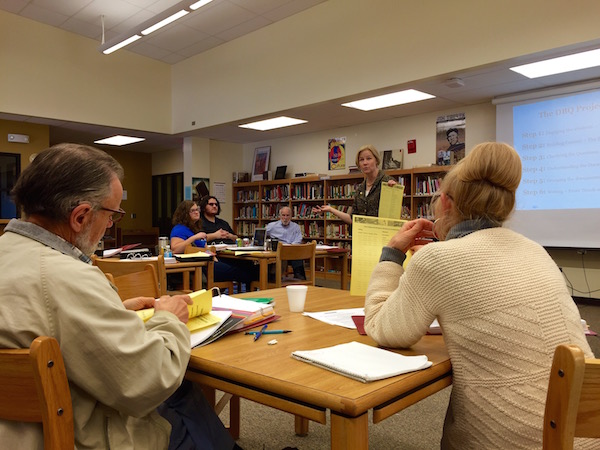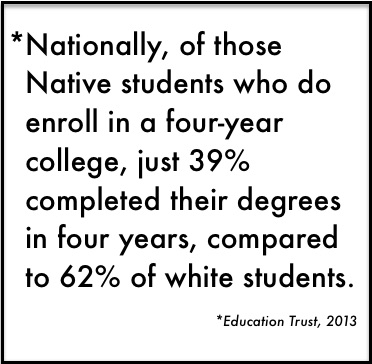School Supports Student Achievement with Innovative Curriculum Development
posted January 26, 2015
 Warm, morning light shown through the windows in the Red Cloud High School Library. Social studies teachers sat, sipping their coffees, preparing for a day devoted to faculty professional development focused on taking students’ research, critical thinking and articulation skills to the next level.
Warm, morning light shown through the windows in the Red Cloud High School Library. Social studies teachers sat, sipping their coffees, preparing for a day devoted to faculty professional development focused on taking students’ research, critical thinking and articulation skills to the next level.
Every few weeks staff join together as a school and within their own departments to compare notes, plan for the future and participate in important educational trainings aimed to strengthen their curricula and provide innovative classroom tools for creating a truly holistic education of the mind, body and spirit.
In 2012, with Common Core sweeping the country, and new South Dakota standards in science and social studies on the way, Red Cloud Indian School knew that their faculty needed all the support they could get. In order to address these important changes, Moira Peckskamp was hired as Red Cloud’s first Director of Curriculum and Assessment.
Responsible for ensuring that faculty have the tools and training they need and thus ensuring that all 600 Red Cloud students have the best possible opportunities to succeed in school, Peckskamp engaged in a results-driven process to analyze three components of Red Cloud’s educational approach: academic curriculum, classroom instruction, and assessment.
She says that while Red Cloud students have been getting into some of the most prestigious colleges and universities in the nation for years, “we need to do more.” She explains that Red Cloud graduates should have achievement and fluency levels that enable them to both enroll in the college or university of their choice and be prepared to meet or exceed the college success rates of their peers nationwide.
“The ultimate goal is to increase the number of students who are college-ready in math, science, English and other core subjects,” says Peckskamp. “The way to get them there is by creating fluency.”
Fluency, while often understood in relation to a language, can actually be gauged across all disciplines. Peckskamp explains that a student can be said to be fluent when they demonstrate flexibility in the methods they choose to seek answers, understand and can explain these methods, and produce accurate answers efficiently.
“Fluency is important because it provides a bridge between recognition and comprehension,” says Peckskamp. “It’s about having a broad understanding of a subject matter, which allows a student to choose the most useful and efficient route to the answer they seek.”
 To bring students to this level of understanding, she first set out to comprehensively test, evaluate and analyze where the school’s curriculum stood. This can be a significant undertaking for a relatively small school, but Peckskamp and her colleagues believed it was a critical activity if they were to overcome the odds stacked against students on the reservation.
To bring students to this level of understanding, she first set out to comprehensively test, evaluate and analyze where the school’s curriculum stood. This can be a significant undertaking for a relatively small school, but Peckskamp and her colleagues believed it was a critical activity if they were to overcome the odds stacked against students on the reservation.
“It’s not always just test scores that we’re looking at,” reminds Peckskamp. “There is a lot of valuable data we can gather—and are gathering—from anecdotal evidence from our alumni to directed gap analyses. We need to know what we are really teaching and what we can teach more of in order to best prepare our students.”
Last year, Peckskamp, with the help of Bridgewater State University, conducted a gap analysis for all English classes from kindergarten to the twelfth grade. After poring over the data, the team identified areas in need of improvement.
The team determined that research skills could be integrated into the curricula year by year. With this information, faculty worked to incorporate lessons on research types, analysis, methods and presentation options into classes starting at the fourth grade. Each year the adjusted curriculum will continue to provide additional research skills and opportunities to utilize what they’ve learned, ultimately leading to a holistic understanding of the research process by the time they graduate—preparing them for college level research.
In order to create lasting understanding—fluency—Peckskamp says they need to think big and vertically align the curricula in this way so that each lesson builds upon the last.
In addition to these analyses and curriculum updates, Peckskamp and high school social studies chair Maka Clifford ‘05 have been working with their colleagues to create curriculum maps to establish a defined structure for Red Cloud’s improved curricula.
“You have to have the curriculum fully mapped to understand the scope and sequence of what needs to be taught,” says Clifford. “If the teacher doesn’t have a firm grasp on what students have already learned, and what they’ll learn the following year, it can be extremely difficult to plan your year, and this can lead to students being asked to learn too much too quickly, or, not enough.”
By determining and documenting objectives for weekly learning, testing, and evaluation, they believe these maps will create a level of confidence and interdepartmental understanding that will allow for better monitoring and evaluation of their methods and strategies.
As faculty deepen their planning and collaboration with their colleagues, student learning will become more fluid from grade to grade, building a cohesive web of understanding that will better prepare them for college.
